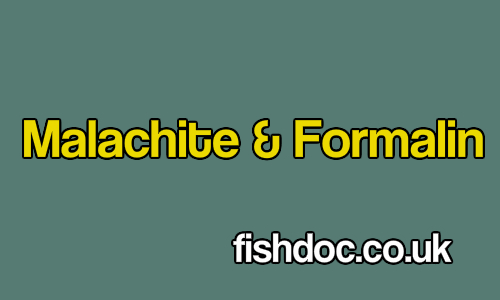Malachite green and formalin treatmentsMalachite Green and Formalin are one of the main cornerstones of fish disease treatments having been used for many years against a range of parasites. They can be used together or separately as anti-parasite treatments against as Gyrodactylus (skin flukes), Dactylogyrus (gill flukes), Ichthyobodo (Costia), Trichodina , Chilodonella and Ichthyophthirius (white spot). The dynamic duo of MG&F is the treatment of choice against white spot (Ich). The relatively long active life of this treatment, together with the low filter toxicity makes it ideal for tackling the complex life cycle of this protozoan parasite. It also has a high success rate with Costia and Chilodonella and would, in most circumstances be my first choice. I have found a mixed result with Trichodina and flukes sometimes a total success, but in other cases not so good. It seems likely that the stronger dosage is needed against these two parasites and a follow up examination to assess the success of the treatment. Malachite green has powerful anti-fungal properties and is used against Saprolegnia (fungus) either when present on fish or to as a prophylactic treatment to protect fish-eggs from infection. It is important to realise that in most cases, fungal infections of fish are secondary infections and unless the primary infection – quite often bacterial – is resolved then anti-fungal treatments such as malachite are unlikely to be successful. Malachite green and formalin are toxic poisonsMalachite green acts as a respiratory poison, damaging the cell’s ability produce energy to drive vital metabolic processes. Formalin is a powerful disinfectant used to kill microorganisms or as a preservative for biological specimens. It works by reacting with cell proteins and nucleic acids – altering both structure and function. These chemicals can be used separately but are usually used together because they exert a synergistic effect; that is, together they give a greater effect than the sum of their separate individual capabilities. They exert a mild anti-bacterial effect and in most circumstances will not destroy biological filtration bacteria, although they may ‘knock the filter back’ for a short while. However, it is still advisable to turn off or by-pass the filter system for a few hours if possible and as with any treatment always turn off any UV lamps. When using to treat against Ichthyophthirius (white spot or Ich) then it is important to keep the system running in order to destroy all stages of the parasite’s life cycle. During prolonged treatments, especially when the filter has not been isolated, it is important to test for ammonia and nitrite on a daily basis in case the filter has been affected. Using malachite green and formalinAs you might expect both of these chemicals are affected by variations in water chemistry. Both can be ‘bound out’ of the system by high dissolved and particulate organics such as fish waste, detritus and algae. Formalin is more toxic in soft, acidic water and also removes oxygen from water so vigorous aeration most be applied. Each 5mg of formalin removes 1 mg of dissolved oxygen from the water. Malachite green is also more toxic at low pH as well as high temperatures. Malachite green has two forms depending on pH. The initial strong green coloured for prevails at low pH (acidic), while in alkaline water it is converted to a colourless carbinol form. So in alkaline water it may seem that it has disappeared, but it is still present, but invisible! More on malachite green and formalin:
Dosage rates: Formalin: Used against protozoan and metazoan parasites. To prevent any misunderstandings, formaldehyde is a colourless, highly toxic gas. Formalin is a 37 – 40% aqueous solution of formaldehyde (which equals 100% formalin). It should not be used if a white precipitate of paraformaldehyde forms in the container. Paraformaldehyde is extremely toxic to fish. Keep formalin away from light and cold. Be extremely careful when handling.
Malachite green: Used against Saprolegnia (fungus), water moulds and protozoan parasites. A zinc-free grade must be used. This is usually mixed as a stock solution that will then keep indefinitely. The exact mixture of the stock solution varies depending on preference. The main point is that whatever concentration is used it should be easy to calculated many mgs of malachite there are per ml of solution. A popular stock solution uses 20 grams malachite per litre of distilled water. This gives 20 mg malachite per ml of stock solution. Using this stock solution.
Malachite and formalin mixture (Leteux-Meyer mixture) Used against protozoan and metazoan parasites. There are several variations. Two commonly used mixtures are:
See the fish disease section for more details about specific parasites or diseases
|

